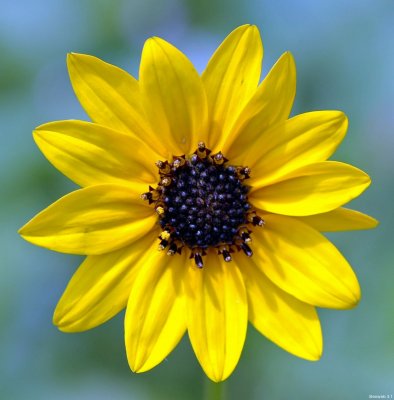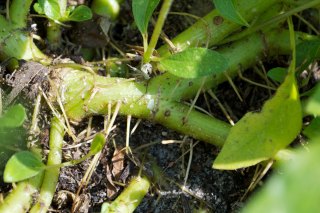Last winter I ordered some seed from a Florida native wildflower nursery to spread in the bare patches in the front (I got rid of a bunch of turf grass with the idea of having a nice wildflower bed instead). I ordered sunshine mimosa (Mimosa strigillosa), Indian Blanketflower (Gaillardia pulchella), and four other species that I hoped would add some color and texture to the yard.
I followed the instructions and was a bit disappointed that only one of the plants came up, and only in one little area, but I’m pretty sure I know why this wildflower crop failed. Most of the birds in our neighborhood are seed-eaters: mourning doves, cardinals, and the like. As I recall, they were watching me spread the seed with a rather keen interest. I’m sure they scooped up the bounty that I so carefully planted.
One reason I’m so sure they’re to blame for my wildflowers not growing where I planted them is because one of the plants I ordered has come up in several places that I didn’t plant it! Helianthus debilis, aka Dune Sunflower, has appeared in at least two places I didn’t sow any seed for it, and one of them happens to be right underneath the gumbo limbo out back, where some of these birds like to sit and, ahem, poop. And I guess that treatment is just what this little flower needs, because take a look at one of the blooms from back there:
According to Gil Nelson, there are 14 native sunflowers in Florida, and H. debilis is one of the more commonly available ones for gardeners. Like most flowers in the world, it’s in the aster family (Asteraceae). According to the entry in the FNPS blog for this plant, sunflowers
have the typical flower head arrangement for this family, which is composed of many florets sharing a single receptacle. The florets arrange themselves to look superficially like a single flower: sterile ray flowers around the edge look like petals, while the central disk florets, arranged spirally, are fertile and produce the seeds.
You can see the fertile florets fairly well in the close-up of the inflorescence above. The pollen-bearing ones are around the outside. If you want a more technical botanic description, see the treatment in the online Flora of North America.
The common name of this plant is dune sunflower, and it really earns its name: it is an important component of dune ecosystems because its low-growing leaves and hairy roots make it an important sand binder on the beach dunes where it grows:
Etymology
The genus name, Helianthus, is from Ancient Greek ἥλιος (helios, “sun”) + ἄνθος (anthos, “flower”). It was named by the originator of modern scientific taxonomy, botanist Carl von Linnaeus. The specific name, debilis, is Latin for weak, frail (cf. French débile.), although I’m not sure where Nuttall came up with this name for the species. Presumably because it grows so low to the ground, unlike it’s more famous 5–6 foot tall cousin. But weak? Fragile? Hardly. It’s actually a fairly hardy little plant, as far as I can tell. The one area where I sowed seed and something came up is right next to the driveway, and the plant is growing out into a little corner. Last weekend during our Memorial Day cookout, the wife had to squeeze too close to it to get out of our driveway and accidentally smushed about a quarter of the plant. All I did was trim off the damaged portion, and the rest of it is going strong!


